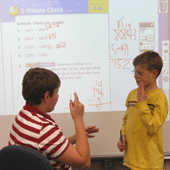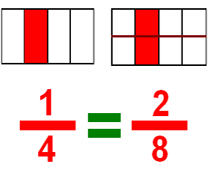| 3.
Construct viable arguments and critique the reasoning of others. |
 |
Mathematically
proficient students understand and use stated assumptions,
definitions, and previously established results in constructing
arguments. |
|
| I
can... |
CONSTRUCT
arguments using concrete objects, drawings, diagrams,
and actions. |
LISTEN
to the arguments of others. |
QUESTION
to clarify or improve the arguments. |
READ
the arguments of others. |
JUSTIFY
my answers. |
RESPOND
to the arguments of others. |
|
CRITIQUE
the arguments of others. |
|
| |
| 4
. Model with mathematics. |
 |
Mathematically
proficient students can apply the mathematics they know
to solve problems arising in everyday life, society,
and the workplace. |
|
| I
can... |
WRITE
equations to describe a situation. |
DRAW
pictures, models, and/or graphic representations. |
IDENTIFY
important quantities in a problem. |
REPRESENT
the problem using manipulatives and/or equations. |
INTERPRET
my mathematical results in context. |
EVALUATE
my solution(s) and make changes if needed. |
|